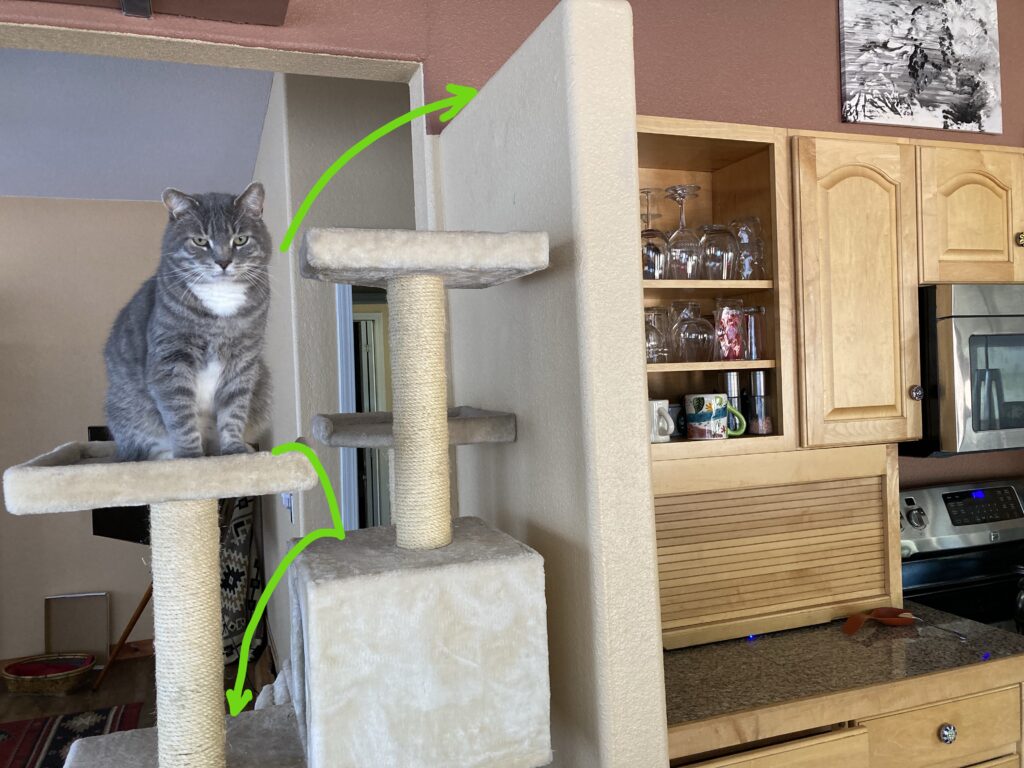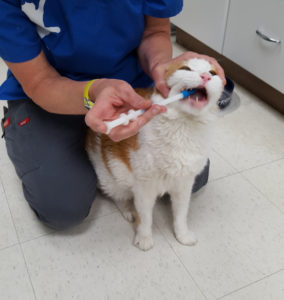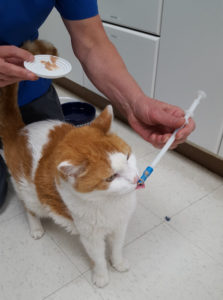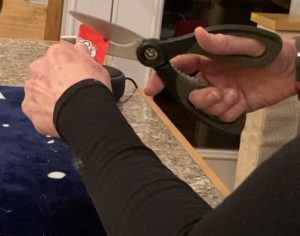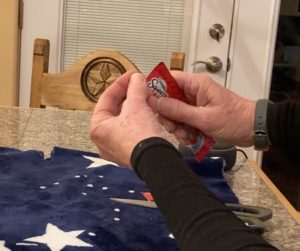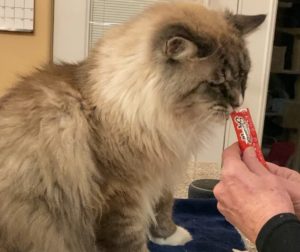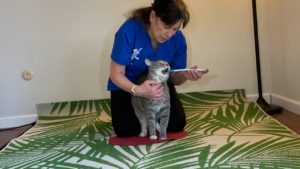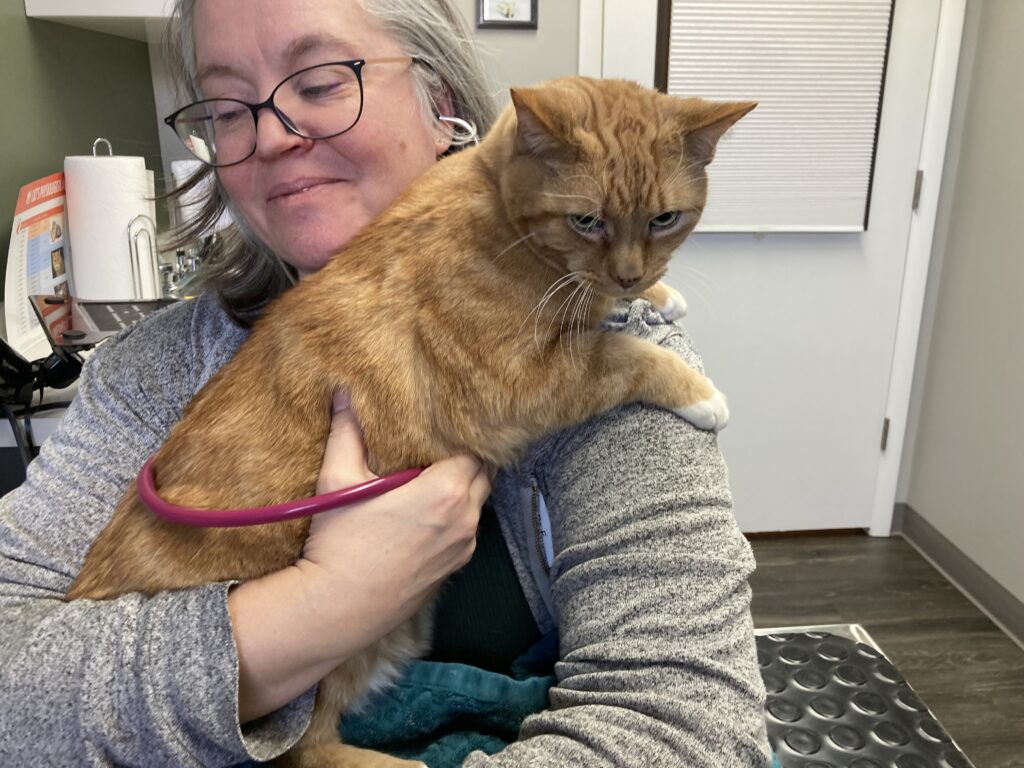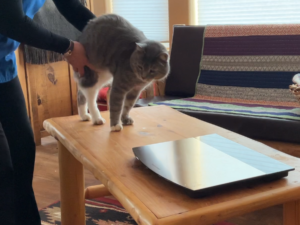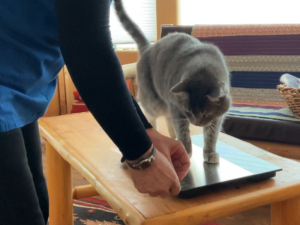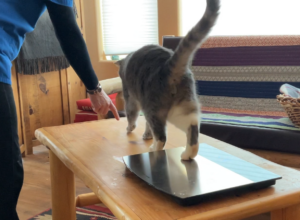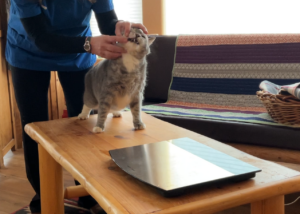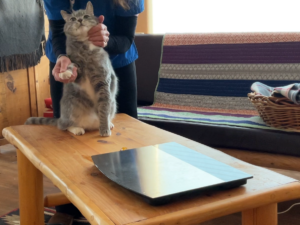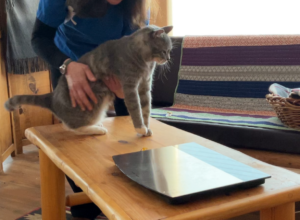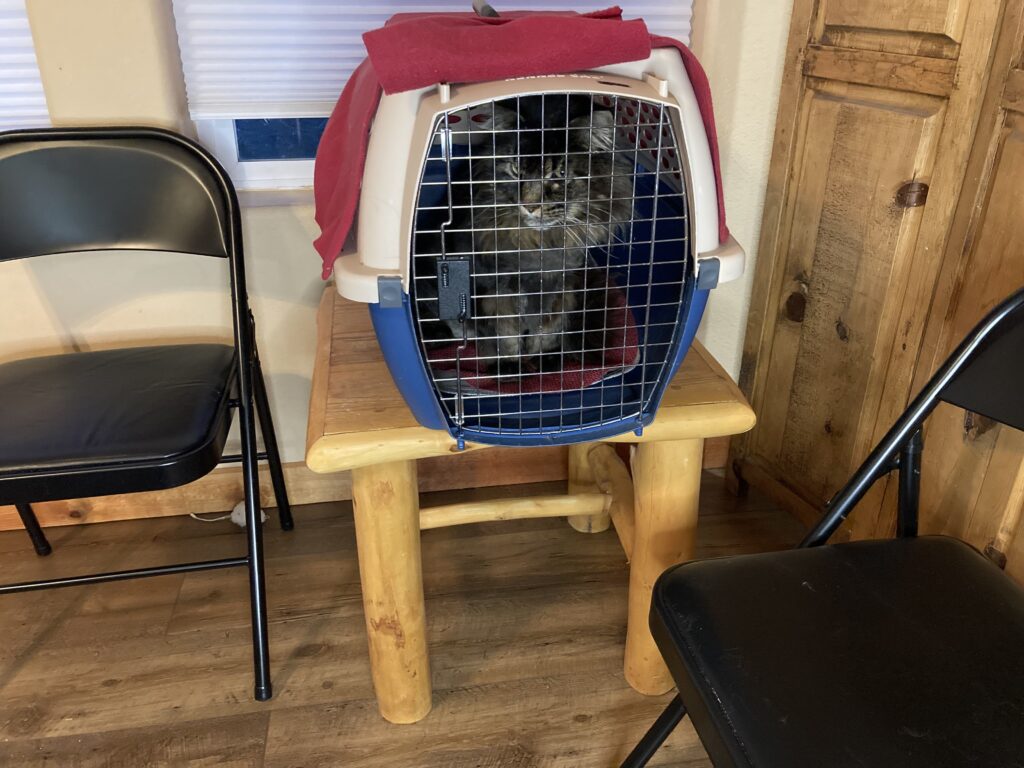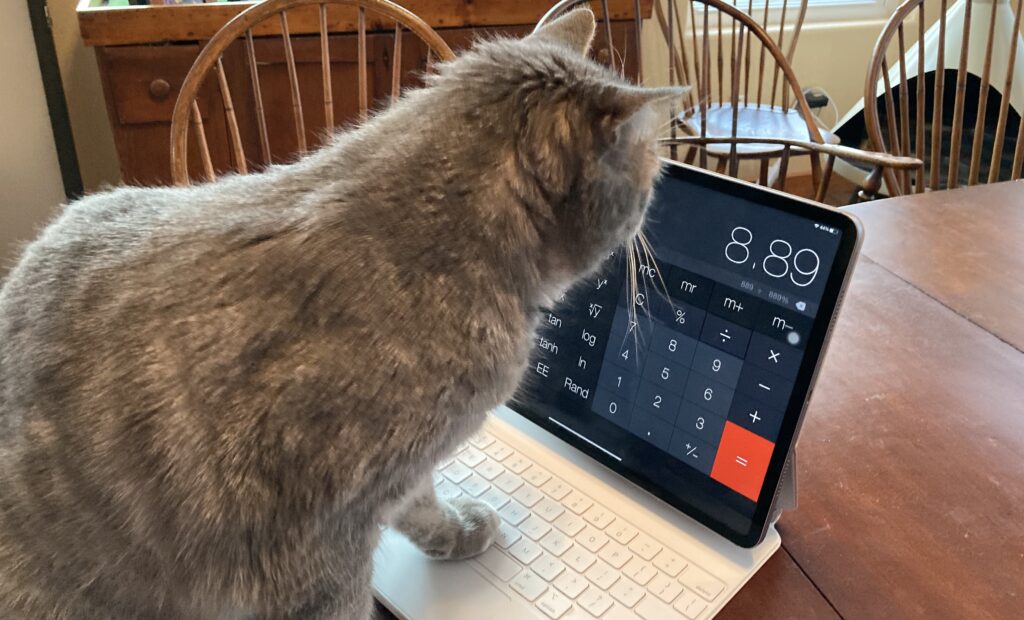
Your cat evolved to eat a diet high in protein. How much protein should you feed your cat? Research suggests feeding enough protein to maintain Lean Body Mass.
Measuring Protein in Food
Nitrogen Balance
The protein content of a food is determined by measuring the nitrogen in it. The difference between the nitrogen we that take in (by eating food) and the nitrogen we put out (in urine) reflects the gain or loss of total body protein and is called the nitrogen balance. Traditionally, the amount of protein that maintains a zero nitrogen balance was considered the minimum protein required to be healthy. [Reference 1]
Nitrogen is one of the most common chemical elements in the universe. The atmosphere surrounding the Earth is about 78% nitrogen. Proteins, those molecules in our bodies that are used to build and repair tissues and act as hormones or enzymes, contain nitrogen.
Lean Body Mass
Recent research in both human and animal nutrition suggests that it is not enough just to maintain a zero nitrogen balance – animals and humans should consume enough protein to maintain their Lean Body Mass (LBM). Lean body mass is the difference between total body weight and the weight of body fat. LBM is made up of the muscle and internal organs.
Muscle and internal organs have a higher metabolic rate than fat. So, a higher percentage of muscle will boost your metabolism, help you maintain a healthy weight, and may help you to live longer. [Reference 2]
How much protein should you feed your cat?
A study followed 24 adult neutered male cats over several months to compare the amount of protein necessary to achieve nitrogen balance with the protein required to maintain LBM (measured by dual energy x-ray absorptiometry or DEXA).
The cats were divided into 3 groups and fed diets with different amounts of protein: one group received a “low” protein diet, the second a “moderate” protein diet and the third group was given a “high” protein diet. [Reference 1]
Results: more dietary protein was required to maintain LBM than to satisfy the nitrogen balance.
- Nitrogen balance was maintained with 1.5 g protein/kg (0.7 g/pound) of body weight.
- LBM was maintained with 5.2 g protein/kg (2.3 g/pound) of body weight .
how much food will give your cat enough protein?
There is no easy answer to this. Not only are there differences in the metabolisms of individual cats and different food formulations, not all the energy in that can or bag of cat food can be metabolized.
To measure how much metabolizable energy (ME) a particular cat food provides your cat, you would need to do a “feeding study”. Such a study measures what goes into the cat and what comes out. The difference is what is metabolized.
Feeding studies are expensive so the pet food industry has devised formulas to estimate the amount of metabolizable energy (ME) in a food using the guaranteed analysis on the pet food label. (The percentage of carbohydrates can be calculated by adding up the protein, fat, crude fiber, moisture and ash listed in the guaranteed analysis and subtracting this total from 100%.)
One of the simpler formulas used is the Atwater equation shown below. [Reference 3]
ME (kcal/kg) = [4x Crude Protein(%) + 4 x Carbohydrate (%) + 9 x Crude Fat (%)] x 10
Nutrients for feeding guidelines are reported per 100 kcal of ME. To find out how much protein your cat food provides per 100 kcal of metabolizable food, we return to the crude protein estimate and reference it to the ME.
Grams protein/ 100 kcal ME = [Crude Protein(%) x 1000] / ME (kcal/kg)
How much protein should you feed your cat? Let’s look at some protein estimates using values from a few typical food labels. These calculations are done on an “as fed” basis.
| Crude Protein (%) | Carbohydrate (%) | Crude Fat (%) | ME (kcal/kg) | Protein (grams/100 kcal) | |
|---|---|---|---|---|---|
| Canned A | 12 | 2.1 | 2.2 | 762 | 15.7 |
| Canned B | 10 | 3.8 | 5 | 942 | 10.6 |
| Dry A | 43 | 24.5 | 19 | 4410 | 9.8 |
| Dry B | 33.5 | 30.6 | 21.1 | 4463 | 7.5 |
Let’s take the example of a 10 lb or 4.5 kg cat in average condition – not fat, not thin. Per the research referenced above, this cat would need about 23 grams of protein daily.
The average 10 lb cat burns about 200 kcal daily. Looking at the foods above, 200 kcal of Canned A would give our 10 lb cat more than 23 g protein; Canned B gives him 22 g, a little short of the daily goal. Neither of the dry foods provide enough protein in 200 kcal to meet the lean body mass requirement: Dry A provides 19.6 g per 200 kcal and Dry B, 15 g per 200 kcal.
How much protein should you feed your cat?
- The 5.2 g protein/kg body weight is the result of two studies – more work is needed to establish accurate protein requirements.
- Protein requirements may vary with age, gender, and breed.
- Medical conditions such as chronic kidney disease can also affect your cat’s protein requirements.
Your veterinarian is a good resource for helping you figure out how much protein to feed your cat. He or she can assess your cat’s body and muscle condition and health to determine if your cat is receiving enough protein and calories.
In our next post, we will consider how many calories your cat should eat every day and how Body Condition Score and Muscle Condition Score can give you an idea of your cat’s body composition, muscle-to-fat ratio and nutritional status.
references
- Laflamme DP, Hannah SS. Discrepancy between use of lean body mass or nitrogen balance to determine protein requirements for adult cats. Journal of Feline Medicine and Surgery. 2013;15(8):691-697. doi:10.1177/1098612X12474448
- Zhang X, Wang C, Dou Q, Zhang W, Yang Y, Xie X. Sarcopenia as a predictor of all-cause mortality among older nursing home residents: a systematic review and meta-analysis. BMJ Open. 2018 Nov 12;8(11):e021252. doi: 10.1136/bmjopen-2017-021252.
- Asaro NJ, Guevara MA, Berendt K, Zijlstra R, Shoveller AK. Digestibility Is Similar between Commercial Diets That Provide Ingredients with Different Perceived Glycemic Responses and the Inaccuracy of Using the Modified Atwater Calculation to Calculate Metabolizable Energy. Vet Sci. 2017 Nov 8;4(4):54. doi: 10.3390/vetsci4040054.

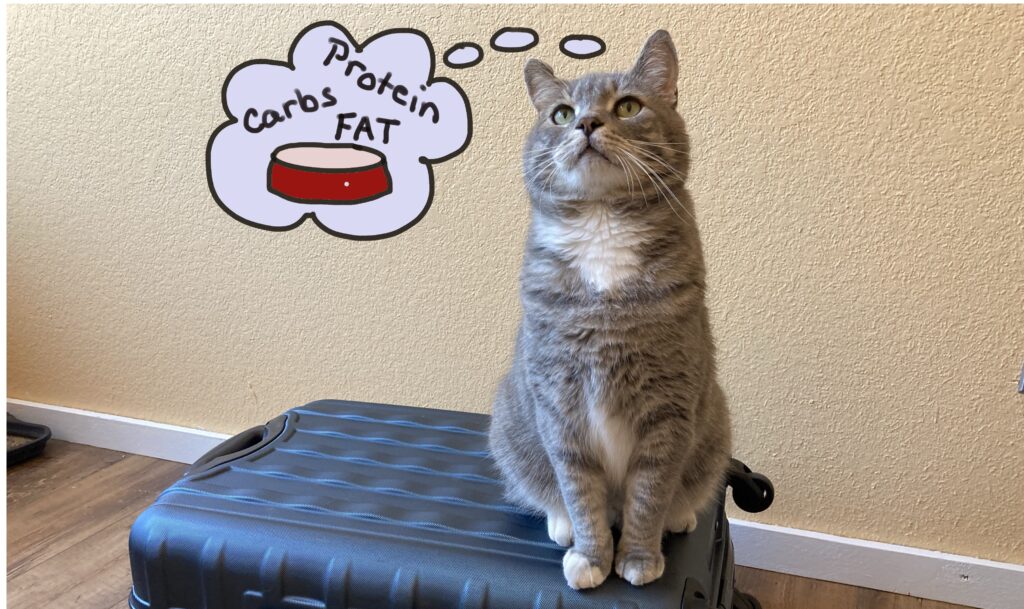
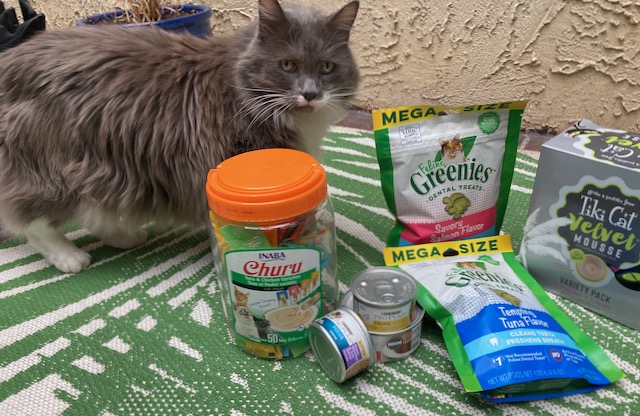 Cats are what we call “obligate carnivores” – they have evolved to eat a diet primarily of animal meat. They have small stomachs, short intestinal tracts, and are designed to eat frequently. A feral cat eats eats the equivalent of 6-8 mice as he hunts from dusk to dawn. In addition to small rodents, reptiles, birds, insects, and rabbits are also on the menu. He consumes the entire prey, including the blood, hair, skin, bones, tendons, and gut contents. These prey are high in protein, have some fat, but little carbohydrate. A feral cat gets about 52% of his energy from protein and 46% from the fat of the prey he eats.
Cats are what we call “obligate carnivores” – they have evolved to eat a diet primarily of animal meat. They have small stomachs, short intestinal tracts, and are designed to eat frequently. A feral cat eats eats the equivalent of 6-8 mice as he hunts from dusk to dawn. In addition to small rodents, reptiles, birds, insects, and rabbits are also on the menu. He consumes the entire prey, including the blood, hair, skin, bones, tendons, and gut contents. These prey are high in protein, have some fat, but little carbohydrate. A feral cat gets about 52% of his energy from protein and 46% from the fat of the prey he eats.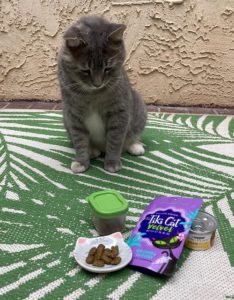
 In celebration of Earth Day, this week’s post continues to focus on sustainable cat care. One of your cat’s essential resources is his litter box. Litter boxes are typically made of plastic but there are many choices of litter box filler. How can your choice of cat box filler help in reducing your cat’s carbon pawprint?
In celebration of Earth Day, this week’s post continues to focus on sustainable cat care. One of your cat’s essential resources is his litter box. Litter boxes are typically made of plastic but there are many choices of litter box filler. How can your choice of cat box filler help in reducing your cat’s carbon pawprint?
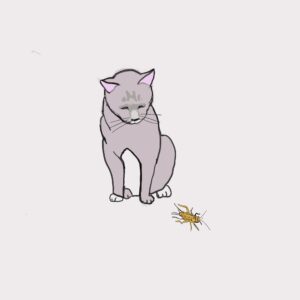
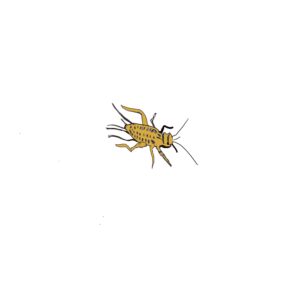 REFERENCES:
REFERENCES: